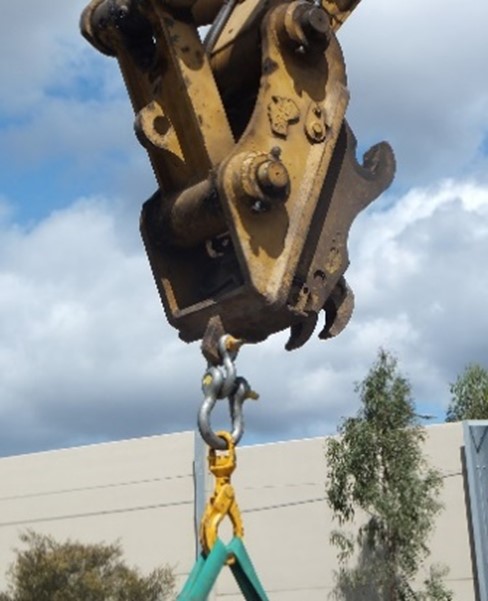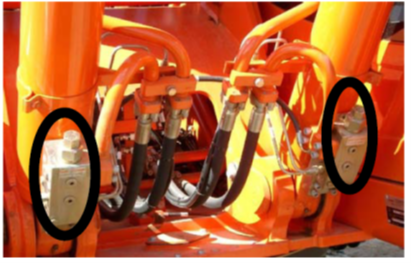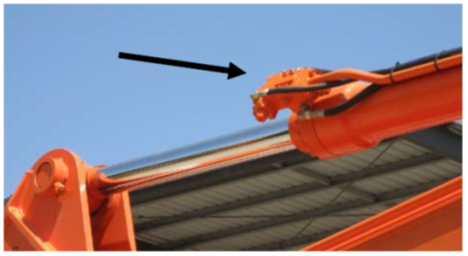Worker struck by steel post at construction site
In March 2022, a worker suffered a chest laceration and internal injuries when he was struck by a steel post.
Early enquiries indicate the worker was part of a team installing a retaining wall at a residential construction site. The steel post had been stood upright, using a sling attached to an excavator in close proximity to the worker. It then appears the steel post has slipped off the sling, striking the worker.
Investigations are continuing.
These findings are not yet confirmed, and investigations are continuing into the exact cause.
Safety issues
Mobile plant (other than a mobile crane) is sometimes used as a mobile crane to lift or lower freely suspended loads. Mobile plant that is used in this way includes earthmoving machinery such as backhoes, front-end loaders and excavators.
Unlike cranes, these types of mobile plant are not specifically designed to lift or suspend loads. As an example, earthmoving plant used in crane mode generally cannot lift in a purely vertical motion like a crane, because it is not fitted with a winch. Lifting of loads may present a risk to the health and safety of nearby people - for example:
- damaged lifting gear causing load failure
- unsecured and dropped loads (falling objects)
- overturning of plant due to unsafe lifting procedures (lifting above the plant’s rated capacity, unstable ground etc)
- posts, being lifted with a sling choked around the post, not being able to hang vertically - this can increase the risk of the post falling over when the crane hook is lowered.
Ways to manage health and safety
Taking steps to manage risks is a condition of doing business in Queensland. Effective risk management starts with a commitment to health and safety from those who manage the business. If an incident occurs, you'll need to show the regulator that you’ve used an effective risk management process. This responsibility is covered by your primary duty of care in the Work Health and Safety Act 2011.
Use the hierarchy of controls to help decide how to eliminate and reduce risks in your place of work. The hierarchy of controls ranks types of control methods from the highest level of protection and reliability to the lowest. It’s a step-by-step approach to eliminating or reducing risks. You must work through the hierarchy of controls when managing risks, with the aim of eliminating the hazard, which is the most effective control.
Possible control measures to prevent similar incidents
There are significant risks associated with using plant that lifts or suspends loads, and severe injuries can result from unsafe use. It is important to note that when mobile plant (other than a mobile crane) is used as a mobile crane, the level of safety provided by the lifting set-up should be at least equal to that when a mobile crane is used. Specific controls are required for this plant including but not limited to s219 of the Work Health and Safety Regulation 2011.
Some common risk control measures can include but are not limited to the following examples. Consider using a mobile crane for the task rather than an excavator, where it is reasonably practicable to do so.
Specific controls
In relation to using other plant such as excavators to lift or suspend loads you need to ensure:
- All lifting points on earthmoving plant form a closed eye, to which a load rated shackle may be attached. Check lifting eyes are load rated and tested. The attachment of lifting lugs to buckets is strongly discouraged due to potential damage to the lifting lug and difficulties being able to estimate how much load may be suspended from the lug (i.e. from the mass of the bucket and any spoil that is lodged inside the bucket). Figure 1 below provides an example of a lifting attachment with a closed eye.

Figure 1: Lifting attachment with a closed eye on excavator
- Burst protection is fitted on the earthmoving plant used as a crane, where the rated capacity exceeds 1 tonne. The burst protection is to be fitted to both the boom and dipper arm of the plant and comply with the performance requirements of ISO 8643: Earthmoving machinery – Hydraulic excavator and backhoe loader boom-lowering control device – Requirements and tests. For earthmoving plant with rated capacities of 1 tonne or less the plant is not to be used to lift loads near workers. One type of burst protection device is shown in Figures 1 and 2 below.

Figure 1: Burst protection fitted to boom cylinders.

Figure 2: Burst protection fitted to dipper arm cylinder.
Source: Technical guidance note:
Earthmoving equipment ― Burst protection on earthmoving equipment used as cranes
- Lifted loads are not to exceed the rated capacity specified by the plant manufacturer.
- Lifting hooks on lifting chains are provided with operable safety latches.
- Shackles used as permanent fittings are prevented from unscrewing (e.g. mousing or similar). Temporary shackles are done up tightly enough so they cannot inadvertently unscrew during the lift.
Safe System of work
Develop a safe system of work when using plant that lifts or suspends loads. This could include but is not limited to the following examples.
- Ensure the mobile plant operator has received adequate training and instruction on the use of the equipment. PCBU’s should assess and verify the operator’s knowledge and competence to operate the plant before they commence work. In some circumstances, the operator of the mobile plant may also need to hold the appropriate high risk work licence class.
- Where a post, pole or similar member is lifted it will usually be easier to lift into position if it is provided with a lifting point at its top where the lifting shackle or chain hook can positively engage. In this situation, the lifted member will hang vertically.
- Where a post, pole or similar member is lifted using a single choked sling around the member, the member will not hang vertically and the risk of workers being struck could be increased. In addition, the choke on the sling may be at risk of dropping when tension is removed from the lifting sling. In this situation, risk control measures need to be implemented to prevent the member becoming unstable and falling on workers.
- Operating the plant on firm level ground.
- When operating the plant in pick-and-carry mode, ensure risk control measures are in place to prevent workers being struck by the load or run over by the plant.
- Using the mobile plant’s load chart to identify each lift point location and the corresponding rated capacity for each position. The appropriate load chart should be fixed inside the operator’s cabin or be readily available to the operator.
- All relevant information, training and instruction should be provided before work begins. Tool box meetings are one way to consult and discuss tasks with workers.
- Establish an effective method of communication between the operator and workers on the ground (e.g. two-way radios and hand signals) and ensure all workers are using the selected method.
- Ensure all lifting gear is:
- inspected for damage and wear by a competent person before each lift and receives a comprehensive inspection at periodical intervals (e.g. not exceeding 12 months for chain slings, more frequent for synthetic lifting slings)
- tagged to identify the date of the lifting gear’s last inspection (documented maintenance records should be available at the workplace)
- used for the appropriate loads being lifted, including adequate capacity and protection from sharp edges
- inspected on a three-monthly interval if synthetic slings are involved (see AS 1353.2: Flat synthetic-webbing slings – Care and use and AS 4497: Round slings – Synthetic fibre for further information).
- Slinging loads - where the person responsible is required to exercise judgement in relation to the suitability and condition of lifting gear and the method of attaching the sling (including sling accessories) to the load or plant, then this person must hold a dogger’s high risk work (HRWL) licence. In addition, a dogger’s HRWL is required where the load is out of view of the plant operator.
- Safe Work Method Statements (SWMS). A PCBU that carries out high risk construction work, including construction work at a site where there is movement of powered mobile plant, must ensure a SWMS is prepared or has already been prepared by another person before the proposed work commences.
- Exclusion zones:
- the size of which must be based on a written risk assessment
- should consider the type of work being performed, the particular movement of the plant and the way the lifted load could fall (for example, with excavator slewing, pedestrians are at risk from the dipper arm and the bucket, as well as the counterweight)
- before allowing workers to enter an exclusion hazardous zone (e.g. within the slew radius of the excavator, the area near a suspended load), the dipper arm should be lowered and the machine turned off or the controls disengaged.
The control measures put in place should be reviewed regularly to make sure they work as planned.
More information
- Mobile crane Code of Practice 2006
- Managing the risks of plant in the workplace Code of Practice 2021 (PDF, 1.57 MB)
- Earthmoving equipment ― Burst protection on earthmoving equipment used as cranes
- Working in and around mobile plant – Film
- AS 1353.2: Flat synthetic-webbing slings – Care and use – Subscription required
- AS 4497: Round slings – Synthetic fibre – Subscription required
Support for people affected by a serious workplace incident
Have you been affected by a workplace fatality, illness or serious injury? For advice and support, visit our Facebook page or email ohs.coronialliaison@oir.qld.gov.au.